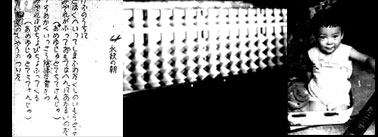Dedication
Introduction
Dan Ariely
Walter Bender
Steve Benton
Bruce Blumberg
V. Michael Bove, Jr.
Cynthia Breazeal
Ike Chuang
Chris Csikszentmihályi
Glorianna Davenport
Judith Donath
Neil Gershenfeld
Hiroshi Ishii
Joe Jacobson
Andy Lippman
Tod Machover
John Maeda
Scott Manalis
Marvin Minsky
William J. Mitchell
Seymour Papert
Joe Paradiso
Sandy Pentland
Rosalind Picard
Mitchel Resnick
Deb Roy
Chris Schmandt
Ted Selker
Barry Vercoe
Hiroshi Ishii
In the Spring of 1995, six months before my departure from Japan to come to MIT, I was finally able to realize a dream that I'd held for quite a number of years: I was able to visit Hanamaki village, the home of the famous author Miyazawa Kenji. Before leaving Japan and moving to Boston, I had wanted to see Kenji's "World of 'Efertobe'" once with my own eyes.
Back in my undergraduate days, when I was hostelling my way across Japan, transferring from one overnight train to the next, a book of Kenji's poems was always among the paperbacks in my backpack. I particularly loved one series of poems ("Pine Needles," "The Last Farewell," "Aomori Elegy," and "Okhotsk Elegy") lamenting the death of his younger sister Toshiko; I read and re-read them until the dog-eared pages were actually fraying. In that book, the conflict in Kenji's heart as he tried to overcome the death of his most beloved sister was expressed in evenly-spaced 9-point type; this was his "poetry"—or so I long thought.

What I saw in the Miyazawa Kenji museum in Hanamaki, though, was an entirely foreign "Last Farewell." In the handwritten manuscript I saw, for each phrase written there seemed to be a re-writing, for every erasure, a new addition. The words danced together, crowded across the yellowed paper of the manuscript sheet. The palimpsest of phrases, piled up in ever-so-slightly differing shades of ink, spoke quietly of his agony. Strangely, when I stared continuously at the lines traced in that ink, I actually began to see his pudgy fingers gripping the pen, and his rugged hand. I even heard the scratching of the pen point across the fiber of the checkered manuscript paper on which he wrote his characters.
That was a feeling I was never able to get from the "Last Farewell" when expressed in typeset characters. Actual vestiges of his physical presence were there, painted onto the discolored, thoroughly stained manuscript paper. These got through to me somehow, and for several minutes I stood there glued to the spot in front of the glass display case. I asked myself: "Is this really the same poem? The same work as the "The Last Farewell" I had known until then from my paperback?"
When, in the process of picking up and setting characters from type drawers, followed by mass duplication on the printing press, all those vestiges of the author's physical presence that were dyed into the original manuscript were wiped away, the artistic work "The Last Farewell" was transformed into a piece of completely "dry" media. But there is one small consolation: there are traces of my own physical presence, and of my mind and spirit as a teenager, in the paperback that traveled with me, in the many margin-jottings and folded page corners scattered throughout it, and in the stains and discolorations from my hands and my adventures. That is why that beat-up old paperback is still there among my personal treasures.
The standardization of character codes, font codes, and page layout all help to improve the efficiency of information storage and the ease with which it can be distributed throughout the Internet-connected world. But I never hear of anyone bemoaning those vestiges of the original artists that are lost when a work is converted into a standardized digital format. I also rarely hear anyone express sadness over the loss of the opportunity for a reader to leave traces of his or her physical presence on a text caused by reading via mouse and screen.
The digital world is a dry one. This is not a necessary consequence of its being digital; it is because of the supremacy of a kind of "technical-efficiency-ism," in which the question of how much information can be trimmed away for compression is given precedence over more fundamental consideration concerning which information it is that conveys human warmth and emotion. The handwritten manuscript of the "Last Farewell" and my dog-eared paperback anthology are both asking us questions about the meaning of the "traces of human presence" missing from the present-day Cyberspace. Here is an origin of my media design.
October 1995 and Future
When I joined MIT in October 1995, I was strongly encouraged by Nicholas Negroponte not to continue my earlier work on video-mediated collaboration media such as ClearBoard. This was a condition of hiring me as a new faculty member of the Media Lab. I was challenged by him to start a new research area from scratch. I took his challenge very seriously, but it was a quite tough problem. During my struggle, Kenji Miyazawa's "The Last Farewell" was always present in my mind. Kenji's manuscript helped me to identify what is most important in the design of digital media for humans. That is why I started "Tangible Bits" project, and I founded the new field of Tangible User Interfaces (TUI) within the universe of Human Computer Interaction (HCI), which seemed to be close to the dead end of digital evolution.
As the field of TUI matures and hopefully finds a widespread following in both academia and industry, I will look forward to taking up yet another new challenge. The theme of my next challenge is likely to be the astronomical archeology.
Favorite childhood toy (also the world's first computer): an abacus